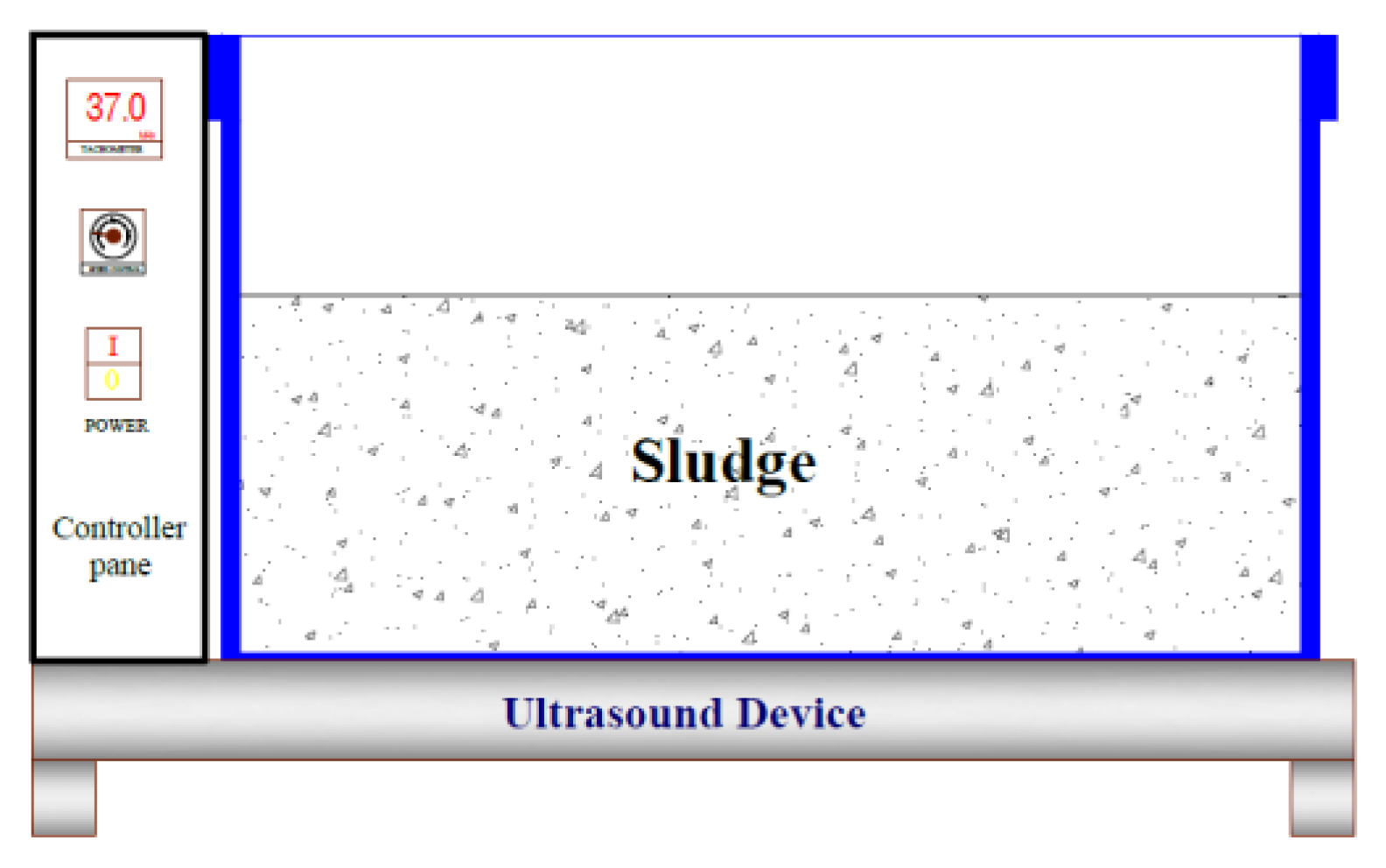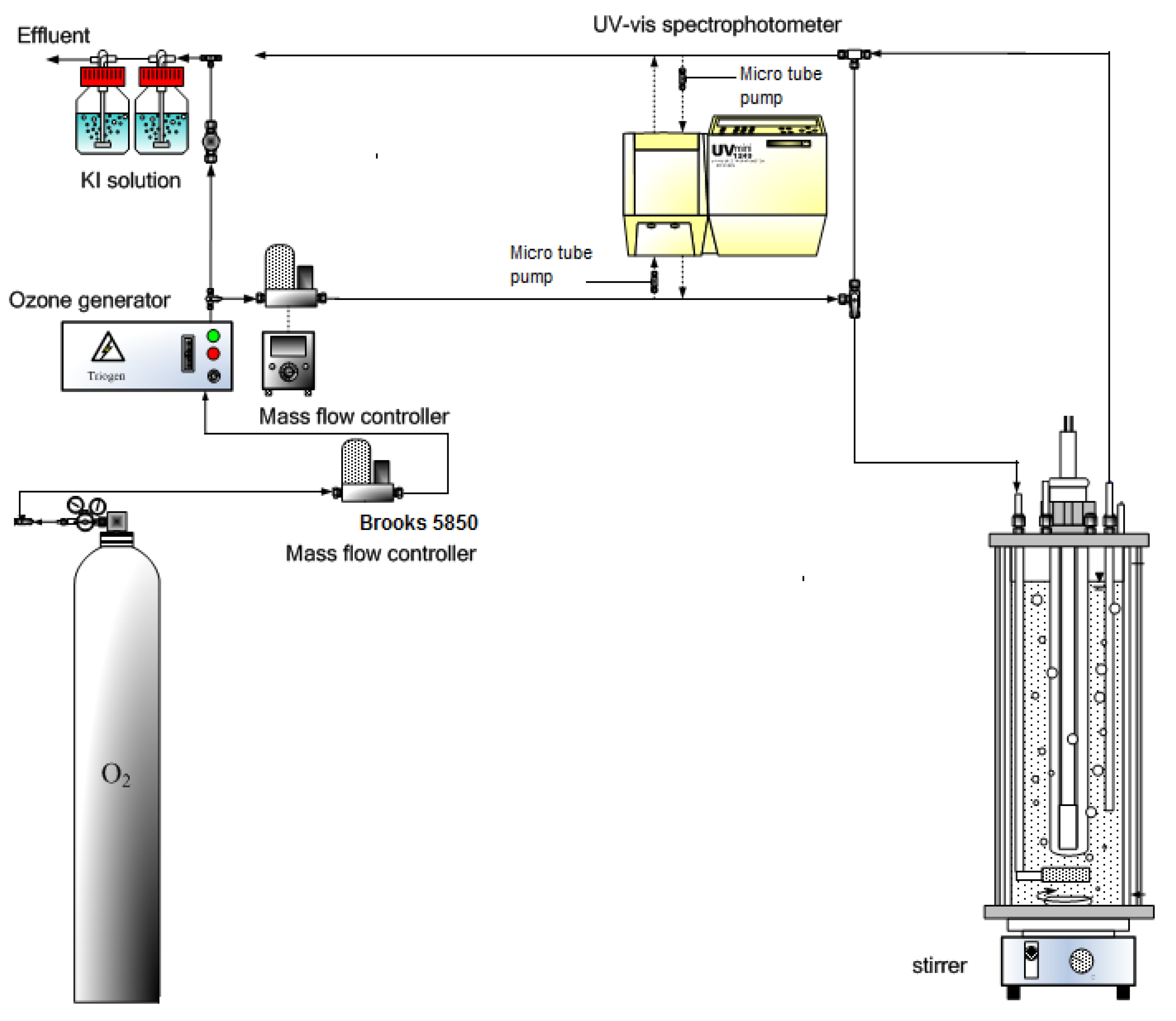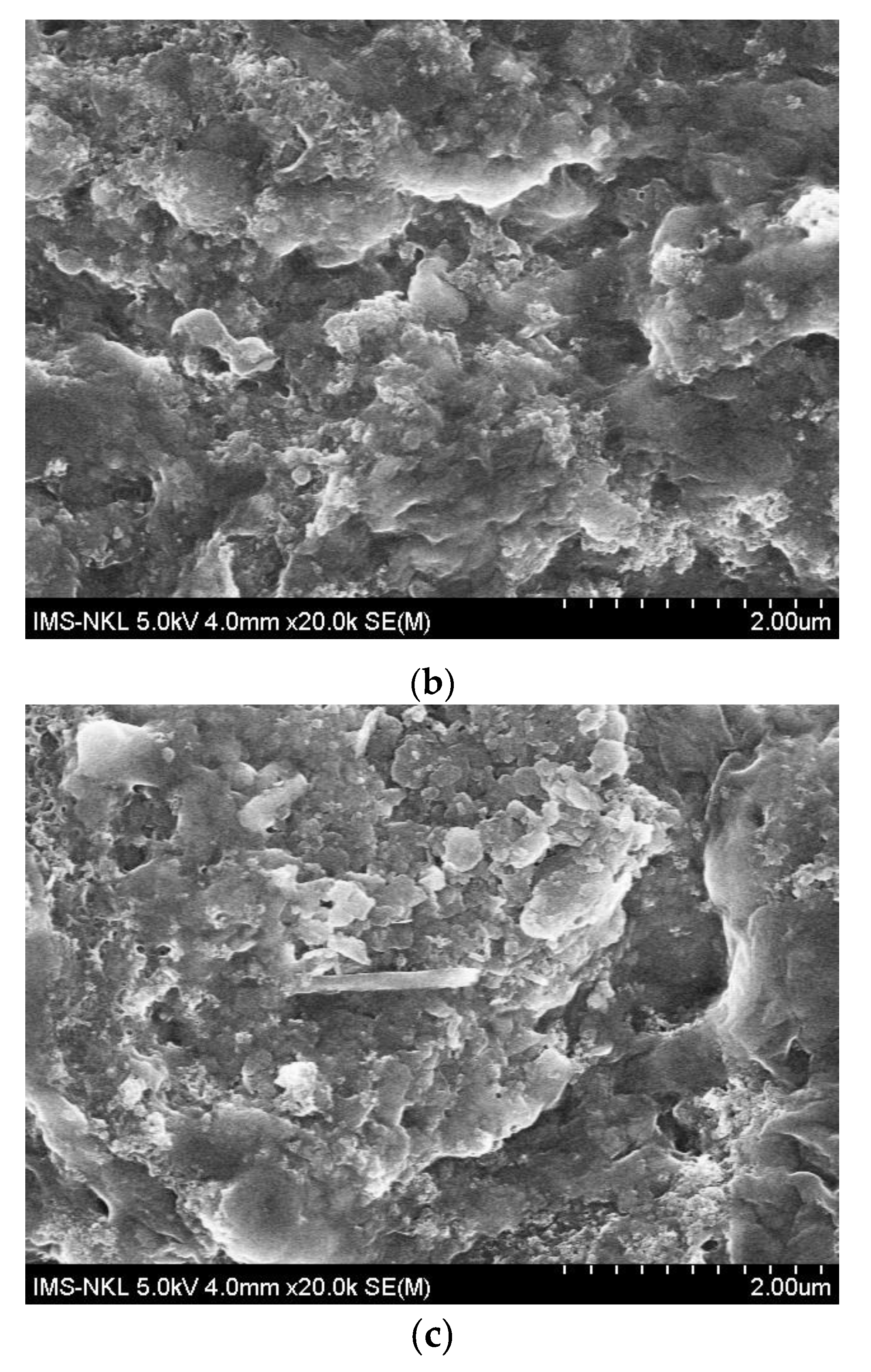Effect of Assisted Ultrasonication and Ozone Pretreatments on Sludge Characteristics and Yield of Biogas Production
Abstract
1. Introduction
2. Materials and Methods
2.1. Sludge Samples
2.2. Sludge Pretreatment Conditions
2.2.1. Ultrasonication Treatment
2.2.2. Ozonation Treatment
2.3. Anaerobic Digestion Assays
2.4. Analytical Methods
2.5. Statistical Analysis
3. Results and Discussion
3.1. Effect of Pretreatments on Characteristics of Sludge
3.2. COD and Biopolymers Solubilisation
3.3. Biogas Production
3.3.1. Daily Biogas Production from Anaerobic Digestion of Digested Sludges Pretreated by Ultrasound and Ozonation
3.3.2. Cumulative Biogas Production from Anaerobic Digestion of Digested Sludge Pretreated by Ultrasound and Ozonation
3.4. COD and VS Removal Efficiencies
3.5. Microstructure Based on SEM
4. Conclusions
Author Contributions
Funding
Conflicts of Interest
References
- Appels, L.; Baeyens, J.; Degreve, J.; Dewil, R. Principles and potential of the anaerobic digestion of waste-activated sludge. Prog. Energy Combust. Sci. 2008, 34, 755–781. [Google Scholar] [CrossRef]
- Nielsen, H.B.; Thygesen, A.; Thomsen, A.B.; Schmidt, J.E. Anaerobic digestion of waste activated sludge—Comparison of thermal pretreatments with thermal inter-stage treatment. J. Chem. Technol. Biotechnol. 2010, 86, 238–245. [Google Scholar] [CrossRef]
- Kothari, R.; Tyagi, V.V.; Pathak, A. Waste-to-energy: A way from renewable energy sources to sustainable development. Renew. Sust. Energ. Rev. 2010, 14, 3164–3170. [Google Scholar] [CrossRef]
- Munster, M.; Lund, H. Comparing waste-to-energy technologies by applying energy system analysis. Waste Manag. 2010, 30, 1251–1263. [Google Scholar] [CrossRef] [PubMed]
- Tian, X.; Trzcinski, A.P.; Lin, L.L.; Ng, W.J. Enhancing sewage sludge anaerobic “re-digestion” with combinations of ultrasonic, ozone and alkaline treatments. J. Environ. Chem. Eng. 2016, 4, 4801–4807. [Google Scholar] [CrossRef]
- Mata-Alvarez, J.; Macé, S.; Llabrés, P. Anaerobic digestion of organic solid wastes. An overview of research achievements and perspectives. Biores. Technol. 2000, 74, 3–16. [Google Scholar] [CrossRef]
- Pavlostathis, S.G.; Giraldo-Gomez, E. Kinetics of anaerobic treatment: A critical review. Crit. Rev. Environ. Control 1991, 21, 35–39. [Google Scholar] [CrossRef]
- Takashima, M. Examination on process configurations incorporating thermal treatment for anaerobic digestion of sewage sludge. J. Environ. Eng. 2008, 134, 543–549. [Google Scholar] [CrossRef]
- Riau, V.; De la Rubia, M.A.; Perez, M. Upgrading the temperature-phased anaerobic digestion of waste activated sludge by ultrasonic pretreatment. Chem. Eng. J. 2015, 259, 672–681. [Google Scholar] [CrossRef]
- Pilli, S.; Yan, S.; Tyagi, R.D.; Surampalli, R.Y. Anaerobic digestion of ultrasonicated sludge at different solids concentrations—Computation of mass-energy balance and greenhouse gas emissions. J. Environ. Manag. 2015, 157, 250–261. [Google Scholar] [CrossRef]
- Braguglia, C.M.; Gianico, A.; Mininni, G. Laboratory-scale ultrasound pre-treated digestion of sludge: Heat and energy balance. Bioresour. Technol. 2011, 102, 7567–7573. [Google Scholar] [CrossRef] [PubMed]
- Martin, M.A.; Gonzalez, I.; Serrano, A.; Siles, J.A. Evaluation of the improvement of sonication pre-treatment in the anaerobic digestion of sewage sludge. J. Environ. Manag. 2015, 147, 330–337. [Google Scholar] [CrossRef]
- Houtmeyers, S.; Degreve, J.; Willems, K.; Dewil, R.; Appels, L. Comparing the influence of low power ultrasonic and microwave pre-treatments on the solubilisation and semi-continuous anaerobic digestion of waste activated sludge. Bioresour. Technol. 2014, 171, 44–49. [Google Scholar] [CrossRef] [PubMed]
- Weemaes, M.; Grootaerd, H.; Simoens, F.; Verstraete, W. Anaerobic digestion of ozonized biosolids. Water Res. 2000, 34, 2330–2336. [Google Scholar] [CrossRef]
- Beszedes, S.; Kertesz, S.; Laszlo, Z.; Szabo, G.; Hodur, C. Biogas production of ozone and/or microwave-pretreated canned maize production sludge. Ozone Sci. Eng. 2009, 31, 257–261. [Google Scholar] [CrossRef][Green Version]
- Cheng, C.J.; Hong, P.K.A. Anaerobic digestion of activated sludge after pressure-assisted ozonation. Bioresour. Technol. 2013, 142, 69–76. [Google Scholar]
- Kumar, M.S.K.; Kumar, T.K.; Arulazhagan, P.; Kumar, S.A.; Yeom, I.T.; Banu, J.R. Effect of alkaline and ozone pretreatment on sludge reduction potential of a membrane bioreactor treating high-strength domestic wastewater. Desalin. Water Treat. 2015, 55, 1127–1134. [Google Scholar]
- American Public Health Association. Water environment federation. In Standard Methods for The Examination of Water and Wastewater, 20th ed.; American Public Health Association: Washington, DC, USA, 1998; ISBN -13 978-0875532356. [Google Scholar]
- Goldstein, J.I.; Newbury, D.E.; Michael, J.R.; Ritchie, N.W.; Scott, J.H.J.; Joy, D.C. Scanning Electron Microscopy and X-Ray Microanalysis; Springer: New York, NY, USA, 2017; ISBN 0-306-40768-X. [Google Scholar]
- Bougrier, C.; Albasi, C.; Delgenes, J.P.; Carrère, H. Effect of ultrasonic, thermal and ozone pre-treatments on waste activated sludge solubilisation and anaerobic digestion biodegradability. Chem. Eng. Process. Process Intensif. 2006, 45, 711–718. [Google Scholar] [CrossRef]
- Bougrier, C.; Baltimelli, A.; Delgenes, J.P.; Carrère, H. Combined ozone pre-treatment and anaerobic digestion for the reduction of biological sludge production in wastewater treatment. Ozone Sci. Eng. 2007, 29, 201–206. [Google Scholar] [CrossRef]
- Shao, L.; Wang, G.; Xu, H.; Yu, G.; He, P. Effect of ultrasonic pre-treatment on sludge dewaterability and extracellular polymeric substances distribution in mesophilic anaerobic digestion. J. Environ. Sci. 2010, 22, 474–480. [Google Scholar] [CrossRef]
- Chu, L.B.; Yan, S.T.; Xing, X.H.; Yu, A.F.; Sun, X.L.; Jurcik, B. Enhanced sludge solubilization by microbubble ozonation. Chemosphere 2008, 72, 205–212. [Google Scholar] [CrossRef] [PubMed]
- Zhen, G.; Lua, X.; Katoc, H.; Zhaod, Y.; Lia, Y.Y. Overview of pretreatment strategies for enhancing sewage sludge disintegration and subsequent anaerobic digestion: Current advances, full-scale application and future perspectives. Renew. Sust. Energ. Rev. 2017, 69, 559–577. [Google Scholar] [CrossRef]
- Kim, D.H.; Jeong, E.; Jeong, E.; Oh, S.E. Combined (alkaline + ultrasonic) pre-treatment effect on sewage sludge disintegration. Water Res. 2010, 44, 3093–3100. [Google Scholar] [CrossRef] [PubMed]
- Tian, X.; Trzcinski, A.; Chong, W.; Lin, L.; Wun, J.N. Insights on the solubilization products after combined alkaline and ultrasonic pre-treatment of sewage sludge. J. Environ. Sci. 2015, 29, 97–105. [Google Scholar] [CrossRef]
- Salihu, A.; Alam, M.Z. Pre-treatment methods of organic wastes for biogas production. J. Appl. Sci. 2016, 16, 124–137. [Google Scholar] [CrossRef]
- Carrère, H.; Dumas, C.; Battimelli, A.; Batstone, D.J.; Delgenès, J.P.; Steyer, J.P.; Ferrer, I. Pre-treatment methods to improve sludge anaerobic degradability: A review. J. Hazard Mater. 2010, 183, 1–15. [Google Scholar] [CrossRef]
- Wang, Q.; Kuninobu, M.; Kamimoto, K.; Ogawa, H.I.; Kato, Y. Upgrading of anaerobic digestion of waste activated sludge by ultrasonic pre-treatment. Biores. Technol. 1999, 68, 309–313. [Google Scholar] [CrossRef]
- Lafitte-Trouque, S.; Forster, C.F. The use of ultrasound and gamma-irradiation as pre-treatments for the anaerobic digestion of waste activated sludge at mesophilic and thermophilic temperatures. Biores. Technol. 2002, 84, 113–118. [Google Scholar] [CrossRef]
- Barber, W.P.F. Thermal hydrolysis for sewage treatment: A critical review. Water Res. 2018, 104, 53–71. [Google Scholar] [CrossRef]
- Campo, G.; Cerutti, A.; Zanetti, M.C.; Scibilia, G.; Lorenzi, E.; Ruffino, B. Enhancement of waste activated sludge (WAS) anaerobic digestion by means of pre- and intermediate treatments. Technical and economic analysis at a full scale WWTP. J. Environ. Manag. 2018, 216, 372–382. [Google Scholar] [CrossRef]
- Ortega-Martinez, E.; Sapkaite, I.; Fdz-Polanco, F.; Donoso-Bravo, A. From pretreatment toward inter-treatment. Getting some clues from sewage sludge biomethanation. Bioresour. Technol. 2016, 212, 227–235. [Google Scholar] [CrossRef] [PubMed]
- Takashima, M.; Tanaka, Y. Comparison of thermo-oxidative treatments for the anaerobic digestion of sewage sludge. J. Chem. Technol. Biotech. 2008, 83, 637–642. [Google Scholar] [CrossRef]
- Boni, M.R.; D’Amato, E.; Polettini, A.; Pomi, R.; Rossi, A. Effect of ultrasonication on anaerobic degradability of solid waste digestate. Waste Manag. 2016, 48, 209–217. [Google Scholar] [CrossRef] [PubMed]
- Long, J.H.; Bullard, C.M. Waste activated sludge pretreatment to boost volatile solids reduction and digester gas production: Market and technology assessment. Fla Water Resour. J. 2014, 44–50. Available online: http://fwrj.com/techarticles/0614%20tech%202.pdf (accessed on 3 September 2019).
- Chu, C.P.; Lee, D.J.; Chang, B.; You, C.S.; Tay, J.H. “Weak”, ultrasonic pretreatment on anaerobic digestion of flocculate activated biosolids. Water Res. 2006, 36, 2681–2688. [Google Scholar] [CrossRef]
- Li, H.; Jin, R.; Mahar, Z.; Wang, Z.; Nie, Y. Effects and model of alkaline waste activated sludge treatment. Bioresour. Technol. 2008, 99, 5140–5144. [Google Scholar] [CrossRef] [PubMed]







| Parameter | Unit | Study Control a | Ultrasonication | Ozonation | Reference b | |
|---|---|---|---|---|---|---|
| [11] | [12] | |||||
| COD | g/L | 54.148 ± 3.1 | 54.128 ± 1.42 | 54.136 ± 3.21 | 19 | 160 ± 4 |
| SCOD | g/L | 0.344 ± 0.05 | 1.023 ± 0.08 | 1.228 ± 0.06 | 0.08 | |
| TS | g/L | 174.1 ± 1.11 | 158.2 ± 1.76 | 164.0 ± 1.45 | 23 | 132 ± 1 |
| VS | g/L | 111.33 ± 1.23 | 112.0 ± 1.34 | 109.23 ± 1.88 | 13.5 | 88 ± 2 |
| Retention Time (Days) | VS Removal Efficiency (%) | COD Removal Efficiency (%) | ||||
|---|---|---|---|---|---|---|
| Without Pretreatment | With Ultrasound | With Ozonation | Without Pretreatment | With Ultrasound | With Ozonation | |
| 5 | 2.52 | 8.34 | 6.55 | 8.09 | 12.41 | 13.41 |
| 10 | 18.85 | 29.34 | 21.04 | 27.87 | 27.47 | 27.80 |
| 15 | 41.43 | 45.89 | 52.01 | 37.00 | 41.59 | 43.16 |
| 20 | 42.60 | 55.81 | 59.46 | 38.97 | 53.17 | 57.07 |
| 25 | 43.15 | 58.21 | 61.06 | 39.18 | 55.90 | 64.31 |
© 2019 by the authors. Licensee MDPI, Basel, Switzerland. This article is an open access article distributed under the terms and conditions of the Creative Commons Attribution (CC BY) license (http://creativecommons.org/licenses/by/4.0/).
Share and Cite
Le, T.M.; Vo, P.T.; Do, T.A.; Tran, L.T.; Truong, H.T.; Xuan Le, T.T.; Chen, Y.-H.; Chang, C.-C.; Chang, C.-Y.; Tran, Q.T.; et al. Effect of Assisted Ultrasonication and Ozone Pretreatments on Sludge Characteristics and Yield of Biogas Production. Processes 2019, 7, 743. https://doi.org/10.3390/pr7100743
Le TM, Vo PT, Do TA, Tran LT, Truong HT, Xuan Le TT, Chen Y-H, Chang C-C, Chang C-Y, Tran QT, et al. Effect of Assisted Ultrasonication and Ozone Pretreatments on Sludge Characteristics and Yield of Biogas Production. Processes. 2019; 7(10):743. https://doi.org/10.3390/pr7100743
Chicago/Turabian StyleLe, Tuan Minh, Phong Thanh Vo, Tuan Anh Do, Lien Thi Tran, Hoa Thi Truong, Thanh Thao Xuan Le, Yi-Hung Chen, Chia-Chi Chang, Ching-Yuan Chang, Quoc Toan Tran, and et al. 2019. "Effect of Assisted Ultrasonication and Ozone Pretreatments on Sludge Characteristics and Yield of Biogas Production" Processes 7, no. 10: 743. https://doi.org/10.3390/pr7100743
APA StyleLe, T. M., Vo, P. T., Do, T. A., Tran, L. T., Truong, H. T., Xuan Le, T. T., Chen, Y.-H., Chang, C.-C., Chang, C.-Y., Tran, Q. T., Thanh, T., & Do, M. V. (2019). Effect of Assisted Ultrasonication and Ozone Pretreatments on Sludge Characteristics and Yield of Biogas Production. Processes, 7(10), 743. https://doi.org/10.3390/pr7100743






